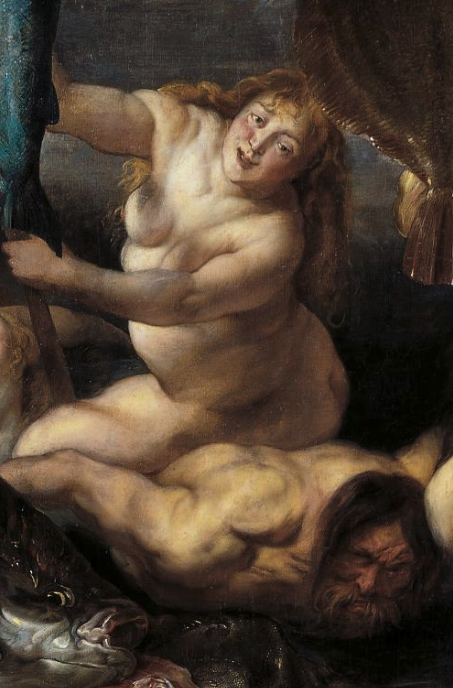
“The Gifts of the Sea” by Jacob Jordaens and Frans Snyders (1640/1650) celebrates a teeming catch being brought to the shore by a throng of naked merfolk. All this takes place under the watch of the commercial god Mercury. The marine divinities slip and slither over each other to the point that some of their poses seem to reflect the prostrate fish bodies arrayed across the lower left half of the painting. And likewise not all the mermen and mermaids are as active now as they might have been cavorting beneath the waves just a few minutes before. There seem to be both piscine and human expressions of memento mori in this marvelously busy picture. The fishy still life offers one of each variety of fat, trophy-fish abundance brought on the best days to a fishmonger’s stall.
The two most prominent divinities emerge in the center-right from the water extending on their tridents fish that are as corpulent as themselves. They are depicted with such verism that one might consider them actual — but unclothed — representations of vendors Jordaens knew from the market in Antwerp. Here, though, in their classical-mythological all-together, they seem to represent an Amphitrite and a Neptune exulting in a triumph over the sea.

Mercury dominates the scene, though unobtrusively. The god of commerce is perched on a high rock to the left. His cherubic protege is clad in Mercury’s petasus cap and bends his fishing rod in the haul. Mercury points with his caduceus right across the diagonal line in the painting that demarcates a limen or threshold along the shoreline. It is the line between reality and fantasy, between fish and human, between life and death, between the transitory and the everlasting frolic of the divine. Two seal pups lie on this divide, one alive and the other apparently dead.
Mercury is the one who directs the catch from the sea into the stalls of Antwerp’s commercial center.
Jordaen’s picture offers a celebration of Flemish livelihood but also a reminder of the fleeting nature of pleasure, of life.
This painting, acquired in 2020 by Prince Hans-Adam II von und zu Liechtenstein, is among the new acquisitions of The Princely Collections of Liechtenstein at Vaduz-Vienna. The Collection’s brilliant website facilitates remote access to the marvelous collection by its links to scholarly bibliography and access to vibrant high-resolution images.
For detailed information and further reading,
see https://www.liechtensteincollections.at/en/collections-online/the-gifts-of-the-sea
